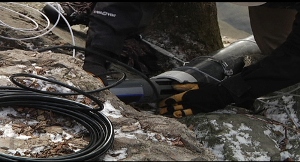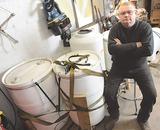Residents of Dimock Township receive $4.1 million
Dimock, Pennsylvania Residents to Share $4.1 Million, Receive Gas Mitigation Systems Under DEP-Negotiated Settlement with Cabot Oil and Gas
Additional $500,000 to Reimburse DEP for Investigative Costs; DEP to Drop Montrose Water Line Plan Given Uncertain Prospects
HARRISBURG, Pa., Dec. 15, 2010 /PRNewswire-USNewswire/ — Residents of Dimock Township, Susquehanna County, who have had their drinking water supplies contaminated by natural gas will each receive a share of $4.1 million that Cabot Oil and Gas Co. will pay under a settlement negotiated by the Department of Environmental Protection and the company.
The settlement, which will enable the affected families to address their individual circumstances as they see fit, also binds Cabot to offer and pay to install whole-house gas mitigation devices in each of the 19 affected homes.
Cabot also will pay DEP $500,000 to offset the state’s expense of investigating the stray gas migration cases that have plagued Dimock residents for nearly two years.
“The 19 families in Dimock who have been living under very difficult conditions for far too long will receive a financial settlement that will allow them to address their own circumstances in their own way,” said DEP Secretary John Hanger, who explained that the amount paid to each family will equal two-times the value of their home, with a minimum payment of $50,000.
“In addition to the significant monetary component of this settlement, there is a requirement that Cabot continue to work with us to ensure that none of their wells allow gas to migrate,” Hanger noted.
DEP began investigating reports of stray gas in Dimock water wells in January 2009. A consent order and agreement signed in November 2009 required Cabot to install whole-house treatment systems in 14 homes, but residents found that action to be unsatisfactory.
The agreement was modified in April 2010 and DEP ordered Cabot to cap three wells believed to be the source of the migrating gas. DEP also suspended its review of Cabot’s pending permit applications for new drilling activities statewide and prohibited the company from drilling any new wells in a nine-square-mile area around Dimock.
In September, DEP announced that Pennsylvania American Water Co. would construct a 5.5-mile water main from its Lake Montrose water treatment plant to supply the affected Dimock residents with a reliable source of quality drinking water. In November, the Pennsylvania Infrastructure Investment Authority, or PENNVEST, approved an $11.8 million grant and loan package for the project, with the commonwealth intending to recover the cost of the project from Cabot.
Given the opposition to the planned water line and the uncertain future the project faces, Hanger said the department would abandon its pursuit of the project.
“Our primary goal at the department has always been to ensure that the wells Cabot drilled in Dimock were safe and that they were not contaminating local private water supplies,” said Hanger. “We’ve made great progress in doing that. Since we initiated our enforcement actions, gas levels in a majority of the contaminated water wells have gone down significantly. This agreement lays the foundation for families to finally put an end to this ordeal.”
Media contact: Michael Smith, 717-787-1323
SOURCE Pennsylvania Department of Environmental Protection
http://www.prnewswire.com/news-releases/dimock-pennsylvania-residents-to-share-41-million-receive-gas-mitigation-systems-under-dep-negotiated-settlement-with-cabot-oil-and-gas-111961099.html
Sensors to Assess Water Quality
http://www.azosensors.com/Details.asp?newsID=1726
Sensors to Assess Water Quality
In order to determine the condition of drinking water due to horizontal gas drilling,  a pre-drilling water examination will be carried out for identifying the variation in water quality before and after the drilling process, with respect to the statements of the residents of Pennsylvania.
a pre-drilling water examination will be carried out for identifying the variation in water quality before and after the drilling process, with respect to the statements of the residents of Pennsylvania.
Various sensors will be employed for executing these tests. Ten of the sensors will be integrated along the branches of the Southern Tier Susquehanna River, for monitoring the quality of the water.
According to Kimberly Dille, of the Susquehanna River Basin Commission, the sensors will be monitoring the conductivity, dissolved oxygen, temperature, pH and the turbidity conditions of the water. He remarked that, the quality will be assessed every five minutes and upon the progression of horizontal gas drilling in New York, the Susquehanna River Basin Commission will be measuring the status of water irrespective of time, to avoid the contamination of water.
Andrew Gavin, of SRBC, commented that, when sensing any change in the normal water quality, a warning will be given to their office, providing rapid alertness to the officials about the condition. The SRBC has been collaborating with the Tioga County Planning Department for detecting areas to install these sensing devices on the Apalachin and Catatonk Creeks. According to Elaine Jardine, Director of Tioga, Planning and detecting the quality of water prior to the drilling process, while drilling and after the drilling process is highly significant for knowing the safety of the drinking water.
The SRBC will be integrating ten sensors in New York and has already installed thirty in Pennsylvania. After the establishment of a monitoring station, anyone can assess the status of water through SRBC.net.
Fracking expert to speak at LCCC
http://citizensvoice.com/news/drilling/fracking-expert-to-speak-at-lccc-1.1076898
Fracking expert to speak at LCCC
Published: December 14, 2010
The Gas Drilling Awareness Coalition is sponsoring a presentation by Cornell University professor Dr. A. R. Ingraffea, “Unconventional Gas Plays: Information for an Informed Citizenry,” at 7 p.m. Thursday in Room 132 of Luzerne County Community College’s Educational Conference Center.
Ingraffea, an expert on hydraulic fracturing, is the Dwight C. Baum professor of Engineering and Weiss Presidential fellow at Cornell University’s School of Civil and Environmental Engineering.
Ingraffea has won numerous awards, done research and development for organizations including the National Aeronautics and Space Administration, the Gas Research Institute, the U.S. Department of Transportation and several private companies, and is on the candidate list for the U.S. Environmental Protection Agency’s Science Advisory Board for the Review of Hydraulic Fracturing Study.
For more information, call 570-266-5116, visit www.gdacoalition.org or e-mail gdacoaltion@gmail.com.
A primer on Marcellus Shale geology and technology offered in webinar
http://live.psu.edu/story/50263#nw69
Monday, December 6, 2010
A primer on Marcellus Shale geology and technology offered in webinar
 University Park, Pa. — By now, many are aware of the huge volume of natural gas held in the deeply buried Marcellus Shale formation and its enormous economic potential for Pennsylvania and neighboring states.
University Park, Pa. — By now, many are aware of the huge volume of natural gas held in the deeply buried Marcellus Shale formation and its enormous economic potential for Pennsylvania and neighboring states.
For those who want to learn more about the Marcellus “play,” Penn State Cooperative Extension is offering a free, Web-based seminar at 1 p.m. on Dec. 16, titled, “Plumbing the Depths in Pa.: A Primer on Marcellus Shale Geology and Technology.”
During the one-hour webinar, Michael Arthur, professor of geosciences, will focus on the geology of the Marcellus Shale and technology for extraction as they influence exploration and development of the natural-gas resource. Co-director of the Penn State Marcellus Center for Outreach and Research, Arthur will answer questions from online participants during the session.
“The middle Devonian Marcellus Formation in the Appalachian Basin of Pennsylvania and New York is estimated to contain in excess of 486 trillion cubic feet of extractable natural gas,” he said. “That is sufficient for more than 20 years supply at the United States’ current rate of consumption.”
Arthur pointed out that there also is the possibility of additional significant shale gas deposits that may be targeted within the same basin — Devonian black shale units above the Marcellus Shale and the Ordovician Utica Shale below.
“In my presentation, I will discuss the geologic characteristics of the Marcellus Shale formation, the estimated volume of gas deposits at various points, and the process and effect of hydraulic fracturing,” Arthur said. “I also will address the continuing concern that drilling operations could allow gas migration into shallow, fresh-water aquifers, which is now being studied intensively.”
The webinar, “Plumbing the Depths in Pa.: A Primer on Marcellus Shale Geology and Technology,” is part of an ongoing series of workshops and events addressing issues related to the state’s Marcellus Shale gas boom. Information about how to register for the webinar is available on the webinar page of Penn State Cooperative Extension’s “Natural Gas” website. .
Additional one-hour webinars will be held at 1 p.m. on the following dates:
— Jan. 20, 2011: “Marcellus Shale Legislation: What Was Accomplished in the 2009-10 Session and What Issues Remain to be Addressed.”
— Feb. 16, 2011: “Dealing with Gas Tax Issues: What You Need to Know.”
— March 17, 2011: “Natural Gas Well Development and Emergency Response and Management.”
Previous webinars, publications and other information on topics such as water use and quality, zoning, gas-leasing considerations for landowners and implications for local communities also are available on the “Natural Gas” website at http://extension.psu.edu/naturalgas.
For more information, contact John Turack, extension educator in Westmoreland County, at 724-837-1402 or by e-mail at jdt15@psu.edu.
Fracking: New drilling method prompts concerns
http://tribune-democrat.com/local/x1531215899/Fracking-New-drilling-method-prompts-concerns
December 13, 2010
Fracking: New drilling method prompts concerns
By Kathy Mellott kmellott@tribdem.com
 John Slesinger of Elton stands next to drums of water he keeps in his basement after he says his well was contaminated by a nearby drilling operation.
John Slesinger of Elton stands next to drums of water he keeps in his basement after he says his well was contaminated by a nearby drilling operation.
JOHNSTOWN — Mention Marcellus Shale natural gas drilling and the subject of “fracking” quickly follows.
Fracking – hydraulic fracturing – is the process used to crack open the deep, dense shale bed that lies more than a mile below earth’s surface.
Estimates are that the Marcellus abundance is so great that Pennsylvania likely will have as many as 100,000 wells in years to come, changing the landscape dramatically.
Knowledge of the gas in the shale bed is not new, but the technology to go after it is new.
Drilling companies are now capable of drilling straight down into the Marcellus Shale, and then outward at an angle into the slanted shale bed.
Fracking involves pumping large volumes of water and sand into a drilled area to break the shale fissures to push out the gas that lies between them.
Geologists, hydrobiologists and the gas industry say fracking has been around for 60 years, not only in the oil-rich Southwest, but in the Northeast.
Fracking has been used safely and efficiently across the U.S. for more than 60 years, and in Pennsylvania since shortly after World War II, according to the Pennsylvania Independent Oil & Gas Association, which wrote: “The goal of the fracking process is to create a pathway of man-made cracks in the rock that allow gas to flow from the shale into the well bore.”
Improved technology allowed for a greater water volume and changes in chemical additives used in the process. That opened the door for the deep shale gases to be reached more economically, said hydrogeologist David Yoxtheimer of Penn State’s Marcellus Center for Outreach and Research.
A bendable well casing is turned horizonally about 500 feet above the Marcellus bed.
The fracking is done through lateral drillings that are 2,000 to 7,000 feet long – opening up a natural gas drainage area.
One well pad with four or more wells can drain the natural gas from a square mile, said Michael Arthur, a geologist and MCOR co-director.
Research being done at Penn State may lead to the use of carbon dioxide and propane in the fracking process. But water continues to be the most common means, Yoxtheimer said.
‘Most previous resource’
The magnitude of the drilling/fracking process, the large volumes of water needed and the potential release of chemicals into nearby waterways concerns many people, including environmentalists.
A recent Tribune-Democrat Web poll of 2,034 readers showed that 1,226, or 60 percent, were concerned about the risks of fracking. A total of 478, or 24 precent, thought the process is safe, while 329, or 16 percent, indicated they have no knowledge of the fracking process.
Ralph Kimber, a Williams-port resident and a member of Responsible Drilling Alliance of Lycoming County, fears there is much that may be learned after the wells are already installed and operational.
“Water will be the most precious resource in the world by the end of this century,” Kimber said.
Others think the concerns are exaggerated.
The Ground Water Protection Council, a national group whose mission is to safeguard water sources, stated in a 2009 report that the potential for groundwater contamination due to hydraulic fracturing is remote.
A huge concern is the potential for human error and carelessness.
The state Department of Environmental Protection reported late last week that it had fined RN Industries Trucking Inc. $3,000 for allegedly storing drilling wastewater in five tanks at a site in Clearfield County.
An April inspection revealed that there were 1,950 barrels, or about 82,000 gallons, of the wastewater on the site in Sandy Township. No spillage or ground contamination was reported, said Dan Spadoni of DEP’s regional office in Williamsport.
A May follow-up inspection showed the site was no longer being used for storage and the wastewater had been removed.
The fine money was put into the state’s Solid Waste Abatement Fund to help pay for environmental cleanups statewide, Spadoni said.
‘Minimum of chemicals’
A concern echoed across the state is the large amount of water that fracking requires – usually between 3 million and 5 million gallons per well, with some well pads hosting six to eight wells.
The water sources vary, but much of the fracking water in Pennsylvania comes from groundwater sources – including local streams and rivers – or is purchased from municipal water companies.
While an increasing number of drilling companies are building pipelines to move water to well sites, much water continues to be transported in tanker trucks.
Water makes up 95 percent of the fracking mix, with sand accounting for 4.5 percent. The rest is comprised of small amounts of various compounds – hydrochloric acid, friction reducers and corrosive inhibitors, Yoxtheimer said.
The solution is mixed at the well site before high pressure injection.
An estimated 70 chemicals can be used in the fracturing process, but most drillers use very few, sometimes only three or four.
“On any given frack job, they’re using a minimum of chemicals,” Yoxtheimer said.
The fracking begins with a “charge” – a big bullet of lead or metal sent into the well. The force punctures through the shale. The water, sand and chemicals are then pumped in, Yoxtheimer said.
Engineers with Chief Gas and Oil call the puncturing device a “perf gun,” which is inserted into the drilled well. The gun uses an electrical current to set off small gunpowder-filled caps to create holes in the shale.
The sand holds the fractures open, allowing the natural gas to escape up the well. The chemicals are needed to allow the process to happen, Yoxtheimer said.
For example, he said, a surfactant reduces surface tension of the water; potassium chloride reduces friction; hydrochloric acid cleans out any cement and prevents clogging.
The industry is striving to reduce the number of chemicals, Yoxtheimer said.
Chief – which has a number of wells in the Cambria-Somerset region – has made progress, said Kristi Gittins, vice president of public affairs.
“We’ve been doing this for 12 years, and we use fewer chemicals now than we ever have,” Gittins said.
DEP’s new Marcellus well and drilling regulations require gas companies to disclose the chemicals used in a well.
‘A lot more stuff’
The fracking is done in an area of geology formed 400 million years ago, an area which once served as ocean floor and today has salt levels 10 times that of sea water, geologists say.
The bulk of the water used for fracking remains in the ground.
Currently, the most troubling part of the process for many is the estimated 10 percent to 15 percent of the frack water that comes back out of the pressurized well. Sometimes the amount can be as high as 20 percent. The back-flow contains some of the chemicals sent down the well, which then have mixed with salty solutions that have formed over hundreds of millions of years.
Frack back-flow has historically been hauled from well sites for processing at approved treatment plants.
But as state regulations have been tightened concerning where and how the water is to be treated. That has, in turn, increased the numbers of drillers who are recycling the water or treating it on-site for reuse, Yoxtheimer said.
The Marcellus formation is relatively dry and has the ability to absorb the 80 percent to 90 percent of the water, sand and chemical solution that remains in the well after the fracturing, Yoxtheimer said.
“Ideally there wouldn’t be any interaction or noticeable disturbance,” he said.
Dennis Beck, chairman of the Cambria County Conservation District’s Water Resources and Watershed Development Committee, sees the potential for big problems.
Beck, who also is a member of the Portage Water Authority, would like to see clearer identification on tanker trucks used when the frack water overflow is taken from a well site.
Generally, signage says the tankers are carrying “brine and residual waste.”
“There is a lot more stuff in there than salty water,” he said.
If a tanker comes around the north of Blue Knob and flips over on the Route 164 hairpin curve at the reservoir, significant problems could result, Beck said.
“The firemen will look at that placard and think it’s just brine and wash it off the highway into the reservoir,” Beck said.
Waste material OK’d for Hazleton mineland
http://www.timesleader.com/news/Waste_material_OK_rsquo_d_for_Hazleton_mineland_12-13-2010.html
Waste material OK’d for Hazleton mineland
A company spokesman sees job creation, but a critic fears a hazardous waste dump.
STEVE MOCARSKY smocarsky@timesleader.com
HAZLETON – The state on Monday approved the use of waste material from coal-fired electric generation plants as fill for some abandoned mineland in southern Luzerne County.
Edwardsville-based Hazleton Creek Properties began the controversial reclamation project five years ago at the 277-acre site bounded by state routes 93, 309 and 924.
Some have opposed using certain types of fill at the site, believing they could harm local water supplies.
Hazleton Creek Properties spokesman Frank Keel said the privately funded reclamation project is arguably the most vetted of its kind in the state. He is sure the application was thoroughly examined and reviewed by the state Department of Environmental Protection and looks forward to the project moving ahead.
“Not only will the HCP project provide much-needed jobs for Hazleton area residents, it will also safely reclaim one of the most dangerous abandoned mines in Pennsylvania and turn it into developable land that will spur the local economy and create still more local jobs,” Keel said.
Todd Wallace, acting director of DEP’s Bureau of Waste Management, said the work will improve public safety and the environment by eliminating about 1.2 miles of dangerous highwalls and reducing acid mine drainage.
Under the terms of the permit, Hazleton Creek Properties will use up to 550,000 cubic yards annually of a mixture of dry flue gas desulfurization waste and coal ash to reclaim 53 acres of the site.
Dry flue gas waste is produced when a lime powder spray mixes with sulfur dioxide emissions in the air pollution control systems of coal-fired power plants.
“This permit will allow Hazleton Creek Properties to begin reclaiming a portion of the site and return it to productive use,” Wallace said.
The project does have detractors.
Bill Lockwood, president of local environmental group Save Us From Future Environmental Risk (SUFFER), said he was not surprised by DEP’s approval, given the agency’s past approval of other site permits despite opposition from environmentalists and some elected officials such as state Rep. Todd Eachus, D-Butler Township.
“It looks like instead of being the future site of an amphitheater, it’s going to be nothing but a hazardous waste dump,” Lockwood said.
A spokesman for Eachus, who has vehemently and vociferously opposed the use of dredged and other materials as fill from the project’s inception, did not return a call seeking comment.
This is the fourth permit regulating fill that DEP has issued. Since 2006, Hazleton Creek Properties has been using regulated fill material such as concrete, bricks, blocks and dredged material to build rail sidings and access roads, and to cap two old landfills at the site.
Two other permits issued this year authorize Hazleton Creek Properties to accept dredged materials, coal ash, and cement and lime furnace dust, as well as crushed construction and demolition material for use as fill.
Hazleton Creek Properties applied for the flue gas desulfurization permit in June. DEP held an informational meeting Aug. 31 and accepted public comment through the end of September.
Putting the Brakes on Natural Gas Fracking
December 13, 2010
Putting the Brakes on Natural Gas Fracking
Fracking, the process of blasting deep rock strata to release methane that can then be pumped to the surface and sold as natural gas, is one of the ugliest innovations the energy industry has come up with. And unlike the ugliness of the Alberta Tar Sands, fracking takes place in pristine rural farmlands of the Appalachian Mountain region, such as Pennsylvania and West Virginia.
Big frack attack: Is hydraulic fracturing safe?
This is an excellent article covering all aspects or hydraulic fracturing.
In the 1953 Looney Tunes cartoon “Much Ado About Nutting,” a frustrated squirrel hauls a coconut around New York City, aware it’s a feast but unable to crack it open. It’s reminiscent of an even trickier and more tantalizing jackpot that had, until recently, eluded the United States for nearly two centuries: shale gas, the hard-shelled dark horse of fossil fuels.
That squirrel never tasted the fruits of his labor, however, while the U.S. started figuring out shale gas by the late 1990s and early 2000s, after nibbling at it since the 1820s. But as shale fever sweeps the country — courtesy of a gas-drilling trick called hydraulic fracturing, aka “fracking” — some Americans have begun to wonder if, like the squirrel, we might be hurting ourselves as much as the protective husk around our prize.
DRAFT NATURAL GAS DEVELOPMENT REGULATIONS
From the Delaware River Basin Commission’s Web Site
http://www.state.nj.us/drbc/
DRAFT NATURAL GAS DEVELOPMENT REGULATIONS
posted December 9, 2010
Written comments accepted through 5 p.m. March 16, 2011. Three public hearings will be scheduled; details will be released as soon as they are confirmed.
Please note that this public rulemaking process must be completed prior to the Commissioners taking any action on the proposed regulations. Such action will be taken at a duly noticed public meeting of the Commission at a future date.
http://www.state.nj.us/drbc/notice_naturalgas-draftregs.htm
Water agency to publish gas drilling regulations
http://online.wsj.com/article/AP01539f691bec4cc08103242571a7f2e2.html
DECEMBER 9, 2010
Water agency to publish gas drilling regulations
WEST TRENTON, N.J. — The agency that oversees water quality and quantity in the Delaware River basin says it has finished work on proposed regulations for the natural gas drilling industry.
The Delaware River Basin Commission announced Wednesday that draft regulations will be available for public review beginning at 9 a.m. Thursday.
The commission has declared a moratorium on Marcellus Shale drilling projects in the Delaware River basin until the rulemaking process is complete. The panel has jurisdiction because the drilling process will require the withdrawal of huge amounts of water from the watershed’s streams and rivers. The commission has also cited the potential for groundwater and surface water contamination.
Drilling is in full swing elsewhere in Pennsylvania.
The DRBC is a compact agency representing the federal government and the states of Delaware, New York, New Jersey and Pennsylvania.


